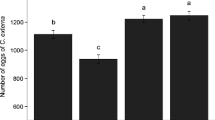Abstract
Full-grown paralyzed larvae ofSpodoptera littoralis, Phthorimaea operculella andAnagasta kuebniella were used as preys for rearingChrysoperla canea larvae.P. operculella induced the shortest larval period, the lowest larval or pupal mortality, highest percent of emergence, longest adult longevity and maximum productivity. Using mature larvae ofS. littoralis gave intermediate values between those reported forP. operculella andA. kuebniella.
Zusammenfassung
Erwachsene, mittels der Methode vonDoutt &Finney (1947) künstlich gelähmte Larven vonSpodoptera littoralis, Phthorimaea operculella undAnagasta kuehniella wurden als Beute für die Aufzucht der räuberischenChrysopa carnea-Larven verwendet.P. operculella als Beute ergab dabei die kürzeste Larvenentwicklung, geringste Larven- und Puppenmortalität, höchste Schlüpfrate, längste Adulten-Lebensdauer und höchste Produktivität. Bei Verwendung von Larven vonS. littoralis als Beute wurden mittlere Werte zwischen jenen vonP. operculella undA. kuehniella erzielt.
Similar content being viewed by others
Literature Cited
Butler, G. D., Jr.;May, C. J., 1971: Laboratory studies of the searching capacity of larvae ofChrysopa carnea for eggs ofHeliothis spp. J. econ Ent.64, 1459–1461.
Doutt, R. L.;Finney, G. L., 1947: Mass-culture technique forDibrachus cavus. J. econ. Ent.40 (4), 577.
El-Dakroury, M.;Abbas, M. S.;El-Heneidy, A. H.;Awadallah, K. T., 1977: The efficiency ofChrysopa carnea Steph. on eggs and larvae ofHeliothis armigera Hb. Agric. Res. Rev.55, 151–156.
Finney, G. L., 1948: CulturingChrysopa californica and obtaining eggs for field distribution. Econ. Ent.41 (5), 719–721.
Finney, G. L., 1950 Mass-culturingChrysopa californica to obtain eggs for field distribution. J. econ. Ent.43 (1), 97–100.
Hafez, M.;Hamid, A. E., 1965: On the feeding habits of the aphid lion,Chrysopa vulgaris Schn. Agric. Res. Rev., Cairo43 (4), 37–46.
Hagen, K. S., 1950: Fecundity ofChrysopa californica as affected by synthetic foods. J. econ. Ent.43 (1), 101–104.
Hassan, S. A., 1975: The mass rearing ofChrysopa carnea Steph. (Neuroptera, Chrysopidae). Z. ang. Ent.79 (3), 310–315.
Hassanein, M. H., 1956: Studies on phenology and population density of the aphid lion,Chrysopa vulgaris Schn. (Neuroptera, Chrysopidae). Ann. Agric. Sci.1 (2), 145–160.
Hydorn, S. B.;Whitcomb, W. H., 1979: Effects of larval diet onChrysopa rufilabris. Florida Entom.62 (4), 293–298.
Kamai, M. 1951: The biological control of the cotton leafworm (Prodenia litura F.) in Egypt. Bull. Soc. Fouad ler Ent.35, 221–270.
Makarenko, G. N., 1975: Effect of the quality of eggs of the grain moth on the rearing of the common chrysopid. Trudy Vsesoy. Nauch. Inst. Zash. Rostenu44, 162–165.
Morrison, R. K.;House, V. S.;Ridgway, R. L., 1975: Improved rearing unit for larvae of a common green lacewing. J. econ. Ent.68 (6), 821–822.
Orphanidis, G. M.;Gonzales, D.;Bartlett, B. K., 1971: Identification and evaluation of pink bollworm predators in southern California. J. econ. Ent.,64 (2), 421–424.
Reed, W., 1965:Heliothis armigera Hb. (Noctuidae) in Western Tanganyika. II. Ecology and natural and chemical control. Bull. ent. Res.56, 140–157.
Ridgway, R. L.;Morrison, R. K.;Badgley, M., 1970: Mass rearing of green lacewing. J. econ. Ent.3, 834–836.
Salama, H. S.;Zaki, F. N.;Sharaby, A. M. 1982: Effect ofBacillus thuringiensis Berl. on parasites and predators of the cotton leafwormSpodoptera littoralis (Boisd.). Z. ang. Ent.94, 498–504.
Sparks, D. N.;Chiang, H. C.;Brukhart, C. C.;Weekman, G. T., 1966: Evaluation of the influence of predation on corn borer population. J. econ. Ent.59 (1), 104–107.
Theron, P. P. A., 1945: The artificial conditioning of lepidopterous larvae for attack by ectoparasitic ichneumonid larvae. J. Ent. Soc. S. Africa8, 111–116.
Tulisalo, M., 1978: An improved rearing method forChrysopa carnea Steph. Annales Agric. Fenn.17 (3), 143–146.
Tulisalo, M.;Kurppa, S. 1973: Mass rearing of the green lacewing,Chrysopa carnea Steph. Ann. Ent. Fenn.29 (3), 143–144.
Tulisalo, M.;Tuovienen, T.;Kurppa, S., 1977: Adults of grain moth,Sitotroga cerealella Ol., as a food source of larvae of the green lacewing,Chrysopa carnea Steph., in mass rearing. Ann. Ent. Fenn.16, 167–171.
Willcocks, F. C., 1937: The insects and related pests of Egypt. I. part 2: Insects and mites injurious to the cotton plant.
Author information
Authors and Affiliations
Additional information
With 3 tables
Rights and permissions
About this article
Cite this article
Zaki, F.N. On the rearing of the aphid lion,Chrysoperla carnea Steph. (Neuroptera, Chrysopidae) on artificially paralized preys. Anz. Schadlingskde., Pflanzenschutz, Umweltschutz 59, 34–36 (1986). https://doi.org/10.1007/BF01908771
Issue Date:
DOI: https://doi.org/10.1007/BF01908771




